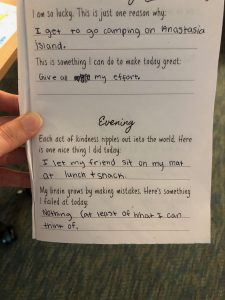The holidays are a joyous and wonderful time of year, but can also be very busy time, and at times, overwhelming. Now that we are back it is time to Children shift into the organized, orderly school day from that unstructured holiday break schedule. As a result, it is inevitable that children may feel some degree of stress from these transitions. Children and teens are still learning to regulate emotions, making them more susceptible to change’s resulting in stress.
Mindfulness is the act of creating awareness of your surroundings, emotions, and physical self in the present moment. It helps you connect to the world around you, while providing cognitive, social, and emotional benefits. Practicing mindfulness is not just for adults. Children can reap a multitude of benefits from learning and practicing mindfulness. Mindfulness equips children with the ability to adjust and deal with conflict encountered in their daily lives. It can also help children foster an optimistic outlook in life, react to stress in a healthy way, and develop a positive self-concept.
The practice of mindfulness is foreign to some adults, making it tricky to teach and model for young children. The best thing to do is keep the message simple and focus on modeling the behaviors. Being taught by an adult that models mindful behaviors daily will assist youth in mastering the techniques. Below are a few mindfulness activities you can do at home as a family or in a group learning environment, such as a 4-H club meeting.
Enjoy Nature
Going on a mindful walk is a simple way to help clear your mind and restore your focus. Taking a nature walk around your neighborhood or park is an easy way to exercise your mindfulness skills and enjoy nature. You can make it exciting by telling them you are going on a “mindfulness safari” and the goal is to see how many different birds, insects, and animals you can find on your journey. Below are some tips for going on a mindful walk:
- Start at a slow pace and gradually increase as the walk continues.
- Pay attention to the feeling in your legs and feet as you take each step. Then, notice how your arms and torso feel as you walk.
- Notice any smells around you.
- Listen to the variety of sounds around you. Notice if the sounds are close or far away.
Meditate
Contrary to what you may think, you do not have to sit silently on the ground with your eyes closed to mediate. You can meditate while you are walking, eating, or doing household chores. The goal of meditation is to slow down and be in the moment. Guided meditation led by a family member are a way to relax and help reduce stress. Below is guided meditation titled “Relationship Fingers” from the University of Minnesota Extension.
Relationship Fingers – Start by holding out your hand with your thumb pointed towards yourself. Take a breath. For each finger we are going to be focusing on a relationship we have with someone. There is no ‘right’ person so don’t worry about who you choose.
- Start by holding your pinky finger and think of someone who is far away from you. Take a breath for them. Really look at that relationship. What do you notice?
- Next focus or touch your ring finger. Think of someone who is leaning on you right now or who may be more vulnerable in this moment. Take a breath for them. Really look at that relationship. What do you notice?
- Hold or focus on your middle finger and think of a leader in your life. Take a breath for them. Really look at that relationship. What do you notice?
- Focus on your pointer finger and think of someone who is close to you. Take a breath for them. Really look at that relationship. What do you notice?
- Last, hold or focus on your thumb. Consider the relationship you have with yourself. Take a good look. What do you notice? What are you committed to? Take one last breath and shake it out.
Gratitude
When we feel and express gratitude to people in our lives, it creates loving connections, builds trust, and makes us feel joyful. Gratitude can be shown by giving someone a hug or telling them how much you appreciate them. Gratitude journals can easily be made at home or you can print off a pre-made template. This version is simple and is a great start for kids: https://researchparent.com/gratitude-journal-for-kids/.
- What’s the best book you’ve ever read? What did you like best about the characters?
- Name one thing that makes you smile every time you hear or see it. Why?
- Describe one thing that made you feel cozy today.
- Who is the one friend you can always rely on?
- What are five things you are looking forward to next year?
Walker, K., Sharpe, K., Anderson, M., Caines, T., Johnson, C., Kennedy, D., Nguyen, K., Odendahl, S., & Santl, K. (2021). Social Emotional Wellbeing: A Guide to Support Youth Thriving. St. Paul: Regents of the University of Minnesota.
- Non-food Rewards for Kids - April 29, 2022
- Keep Mindfulness through the Holiday Back To School Transition - January 6, 2022
- 4-H Day at the North Florida Fair Recap - November 29, 2021


